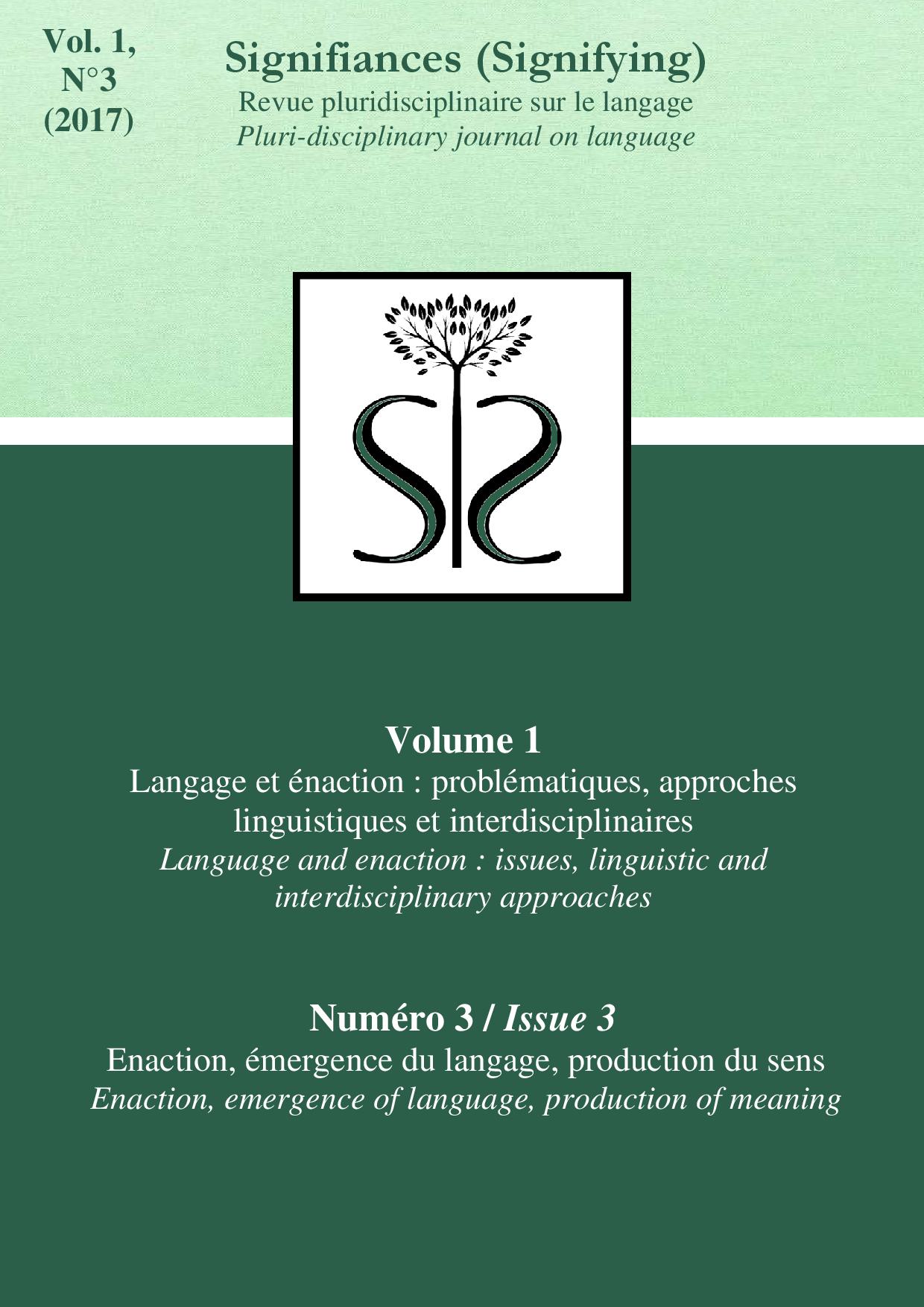Analysis of the SER/ESTAR opposition based on the origins and evolution of {st} saliencing : a submorphological and enactive approach.
DOI :
https://doi.org/10.52497/signifiances.v1i3.87Mots-clés :
SER/ESTAR – submorphology – enaction – salience – signifierRésumé
The theory of submorphemic saliencing has tried to show that the notion of « stability » is often expressed in Spanish through words that include the consonantal group {st}. However, this saliencing is the constitutive marker of the verb estar’s paradigm, generally associated with accidental or circumstantial existence with no essentialising projection, as opposed to the verb ser. Taking a diachronic and synchronic approach based on the signifier, this article aims to explain and understand this apparent contradiction, i.e. the systemic and semantic opposition between ser and estar (sedere/stare). The hypothesis defended in this study is that we are faced with a semantic opposition that can also be seen at the level of the signifiers, which are opposed in two different configurations offering an illustrative example of the motivation of the sign.
Références
BOTTINEAU, Didier (2016, January). Cognématique et chronosyntaxe en espagnol : le cas de st + nt/d. Paper presented at the GERLHis (Groupe d’Études & de Recherches en Linguistique Hispanique) seminars, EA 7345 CLESTHIA. Université Sorbonne Nouvelle – Paris 3.
DANON-BOILEAU, Laurent (1993). Présentation générale. Faits de langues, 1 (1) 5-8.
DELPORT, Marie-France (2012). Estar, seer, ser et yazer, batailles médiévales et conquêtes modernes. L’existence monoactancielle en quête d’une sémiologie. In G. Luquet (ed.), Morphosyntaxe et sémantique espagnoles (p. 155-169). Paris : Presses Sorbonne Nouvelle.
DELPORT, Marie-France (2004). Deux verbes espagnols : Haber et tener. Etude lexico-sémantique. Perspective historique et comparative. Paris : Editions hispaniques.
DELPORT, Marie-France (2000). Voix et aspect. La contribution de ser et du ‘participe’ en espagnol médiéval et moderne. In A. Resano (ed.), Linguistique hispanique. Nantes 1998.
Actes du VIIe colloque de linguistique hispanique, Nantes, 3, 4 et 5 mars 1998 (p. 369-380). Nantes : CRINI.
FONAGY, Yvan (1983). La vive voix. Essais de psycho-phonétique. Paris : Payot.
FORTINEAU-BREMOND, Chrystelle (2015). L’alternance tal ~ atal, tanto ~ atanto en espagnol médiéval : variation ou motivation ? Cahiers de praxématique, 64. Available online <http://praxematique.revues.org/3981> (accessed 2016-08-09).
FREYSSELINARD, Eric (1998). SER Y ESTAR. Le verbe ‘être’ en espagnol. Gap : Ophrys. GARCIA-MARKINA, Yekaterina (2013). Recherches sur l'opposition entre 'ser' et 'estar' en espagnol. Historique de la question et application à l'étude des variations dans leurs emplois en espagnol spontané contemporain au Mexique (PhD thesis). Université de Paris III-Sorbonne Nouvelle, Paris. GRACIA BARRON, Justino & JIMENEZ, Maria (2006). Ir et Ser : étude sémasiologique. In G. Luquet (ed), Le signifié de langue en espagnol (p. 61-77). Paris : Presses Sorbonne Nouvelle.
GREGOIRE, Michaël (2010). Exploration du signifiant lexical espagnol. Structures, mécanismes, manipulations, potentialités. PhD. Paris IV-Sorbonne, Paris. Available at https://tel.archives-ouvertes.fr/tel-00656189/document.
GREGOIRE, Michaël (2012a). Le lexique par le signifiant (méthode en application à l’espagnol). Sarrebruck : Presses Académiques Francophones.
GREGOIRE, Michaël (2012b). Quelle linguistique du signifiant pour le lexique ? Le cas particulier de l’énantiosémie. In G. Luquet (ed), Morphosyntaxe et sémantique espagnoles (p. 139-155). Paris : Presses Sorbonne Nouvelle, GREGOIRE, Michaël (2014). Théorie de la Saillance Submorphologique et neurosciences cognitives. Enonciation et neurosciences cognitives, Synergies Europe, 9, Cracovie, Pologne : Gerflint. 107-119. Available online at <http://gerflint.fr/Base/Europe9/gregoire.pdf> and <https://hal.archives-ouvertes.fr/hal-00961305> (accessed on 2016-08-09)
GUIRAUD, Pierre (1967). Structures étymologiques du lexique français. Paris : Larousse.
LESCANO, A. M (2009). SER / ESTAR + adjectif : Une question de mise en scène. In V. Atayan & D. Pirazzini (ed.), Argumentation : théorie – langue – discours. Actes de la section Argumentation du XXXe Congrès des Romanistes Allemands, Vienne, Septembre 2007 (p. 183-198). Frankfurt am Main : Peter Lang.
LE TALLEC-LLORET, Gabrielle (in press). Sortir de la référentialité : o, do, onde, donde, côté signifiance. In Linguistique du signifiant : diachronie et synchronie. Limoges : Lambert-Lucas.
LUQUET, Gilles (2013). Les formes hay, soy, estoy, doy et voy à la lumière de la cognématique. In N. Delbecque, M.-F. Delport & D. Michaud Maturana (ed.), Du signifiant minimal aux textes. Etudes de linguistique ibéro-romane. Actes du 13ème colloque de linguistique ibéro-romane, Louvain, 2010 (p. 73-83). Limoges : Lambert-Lucas.
LUQUET, Gilles (2010). De l’iconicité des morphèmes grammaticaux en espagnol. In G. Le Tallec-Lloret (ed.), Vues et contrevues. Actes du XIIe Colloque international de linguistique ibéro-romane, Université de Haute-Bretagne, Rennes 2, 24-26 sept. 2008 (p. 73-83). Limoges : Lambert-Lucas.
MACCHI, Yves (2011). Ser et estar, opérateurs de localisation dans le Victorial. Une autre image de l’espace-temps. In A. Desportes & G. Fabre (eds.), Aspects actuels de la linguistique ibéro-romane. Actes du XIe Colloque international de Linguistique ibéro-romane, Paris 13 – Villetaneuse 5-7 octobre 2006 (p. 125-145). Limoges : Lambert-Lucas.
MACIAS BARRES, David (2013). Faits de langue, problèmes d’acquisition et intervention pédagogique : le cas des temps verbaux, du choix modal et de l’opposition SER/ESTAR en espagnol (PhD thesis). Université Paris Ouest Nanterre La Défense, Nanterre.
MOLHO Maurice (1988). L'hypothèse du "formant" : sur la constitution du signifiant espagnol un/no. In C. Benveniste, A. Chervel & M. Gross (ed.), Hommage à Jean –Stéfanini (p. 291-301). Aix-en-Provence : Université de Provence.
PAGES, Stéphane (2015). La motivation du signe en question : approche cognématique des morphèmes en [a] de la langue espagnole. Limoges : Lambert-Lucas.
SAUSSOL, José María (1997). Ser y estar. Orígenes de sus funciones en el Cantar de mio Cid. Seville : Publicaciones de la Universidad de Sevilla.
URRUTIA CÁRDENAS, Hernán & ALVAREZ ALVAREZ, Manuela (1988). Esquema de morfosintaxis histórica del español. Bilbao : Publicaciones de la Universidad de Deusto.
ZALIO, Damien (2013). Étude synchronique contrastive des descendants romans d’ESSE et de STARE : les signifiants italiens essere et stare à la lumière des signifiants espagnols ser et estar (PhD thesis). Université Paris IV-Sorbonne, Paris.
ZINK, Gaston (1986). Phonétique historique du français. Paris : Presses Universitaires de France.


